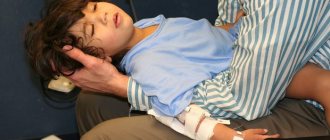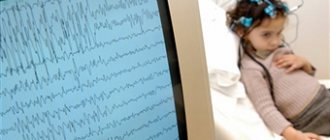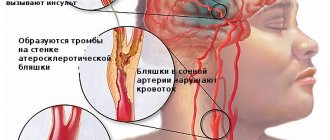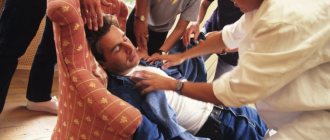Causes
There is still no 100% reliable data on why seizures occur in children with benign childhood epilepsy. The dominant theory in medicine is that the disease is a consequence of minor disorders in brain maturation, which in 60% of cases are genetically determined.
The disease is temporary. As the cortex and frontal lobes mature, epileptic seizures diminish. In general, childhood epilepsy is a classic age-related disorder.
Violations are provoked by a number of factors:
- individual characteristics of the maturation of certain areas of the brain (hippocampus, neocortex, etc.);
- excessive production of excitatory neurotransmitters;
- immaturity of GABA receptors, etc.
Photosensitive epilepsy: is the danger of VR real?
In mid-January on the Rogue Shadow VR
A video has appeared in which one of the participants has a seizure in real life: the character falls to the floor, twitches, and at the same time the player can be heard beginning to breathe heavily and make unintelligible sounds. The rest of the characters crowd around and discuss what can be done and whether anyone knows the unfortunate man in real life. Three minutes later, the player came to his senses, said that he was fine, and after some time left the chat. The video was posted with the permission of the victim himself, and more than a million people watched it.
Most likely, the chat participants witnessed a seizure caused by a form of reflexogenic epilepsy. In simple terms, epilepsy is a “short circuit” - for one reason or another (trauma, infection, genetic mutation), spontaneous impulses arise in the brain, which cause uncontrolled activation of neurons. This in turn can lead to epileptic seizures, which are sometimes accompanied by convulsions and loss of consciousness. They can last from a few seconds to hours and even days, leading to serious brain damage and even death.
We decided to figure out whether new technologies are dangerous for patients with epilepsy and what can be done to protect ourselves.
For people suffering from the reflexogenic form of the disease, a seizure is a peculiar reaction to some external irritant. This could include music, flashing lights, something scary, or even just reading, a hot bath, and some food. About 5% of all patients with epilepsy suffer from this form. In this case, the chat participant most likely had photosensitive epilepsy, in which a seizure can be triggered by a bright flash, flickering light or image on the screen, or sometimes simply a high-contrast picture. According to 2010 data, 1 in 4,000 people are susceptible to seizures caused by visual stimuli. Such cases are most common among patients from 7 to 19 years old. More than 75% of those diagnosed lose photosensitivity in their twenties. According to some data, girls suffer from photosensitivity epilepsy twice as often as young men.
The predisposition to photosensitivity epilepsy can be inherited, but, as with other forms of the disease, some kind of trigger is required for its manifestation. The incidence of reported seizures increased significantly in the 1950s due to the spread of television. Due to the poor quality of picture tubes, the image constantly flickered, causing irritation and headaches even in healthy people. The situation was aggravated by periodic interference, due to which the picture rippled and blinked, and stripes began to run across the screen, which caused seizures in patients. The flicker frequency of the image is one of the decisive factors in photosensitivity epilepsy. According to the study, epilepsy patients were most sensitive to flash frequencies between 16 and 20 Hz, but 49% of patients were susceptible to flicker at 50 Hz. This explains the increased number of seizures caused by watching television, since old cathode-ray picture tubes refreshed the screen 50 times per second. The phosphorus particles had time to “cool down” before the electron beam reached them again, which led to the flickering of the picture. In 1993, special recommendations were developed for manufacturers on screen refresh rates and the use of certain colors. Modern monitors and TV screens mainly use liquid crystal displays, which allows them to achieve an image refresh rate of 70-100 Hz and minimize flicker.
Schematic structure of a cathode ray tube.
A 2007 article describes the curious case of a 9-year-old girl suffering from photosensitive epilepsy. It is interesting because the girl deliberately sat close to the screen, independently provoking epileptic activity in the brain. The fact is that a seizure, in the usual sense, is not an obligatory part of an epileptic attack. During epileptogenic activity, chaotic signals arising in the brain can affect various areas, causing all sorts of sensations, including euphoria and pleasure. Because of this, a “compulsive craving” for triggers is formed, which often happens with photosensitivity. It is also important to pay attention to the fact that the child’s strange behavior did not manifest itself only in the father’s house, where there was an LCD TV.
The use of new technologies makes it possible to reduce the flickering effect to almost nothing, which significantly reduces the risk of an attack in the patient. The comparative safety of watching a film in cinemas is also noted, where, due to the low illumination of the hall, the flickering of the image is not so noticeable, even at a frequency of 24 frames per second. Some studies show that watching movies in 3D is even less risky, as polarized glasses reduce image brightness by up to 50%. However, it is worth remembering that in a cinema the screen occupies almost the entire field of view, which means there is a risk of a seizure caused by what is actually happening on the screen. A widely known case of mass epileptic seizures occurred in Japan on December 16, 1997, when the next episode of the popular cartoon “Pokemon” was shown on television. In one scene, the flash from the explosion was accompanied by a change in red and blue colors with a frequency of approximately 12 Hz. Within four seconds, the flashes took up most of the screen, and within two seconds, the entire screen. While watching the episode, some viewers experienced various symptoms of photosensitivity: from dizziness and nausea to temporary loss of vision and epileptic seizures. 685 people, mostly children, were taken to hospitals that day. After this incident, the broadcast of the animated series was suspended for several months, during which an investigation was carried out. Ultimately, the episode was completely taken off the air, and Japanese doctors and television workers issued several recommendations for video producers:
— The frequency of image blinking, especially red color, should not exceed three times per second. — If there is no red color in the image, then the maximum permissible frequency is five times. — Flashing images should not be displayed for more than two seconds. — It is unacceptable for stripes, spirals and concentric circles to take up most of the screen .
Today, the danger of seizures in photosensitive epilepsy is known to almost all media content producers. Movies, computer games and just videos on the Internet are accompanied by warning signs about possible consequences for people suffering from photosensitivity. Here, as in many other cases, the most reliable way to avoid potentially dangerous situations is to follow simple safety rules. The website of the Australian epilepsy support organization Epilepsy Action Australia notes that the most common triggers for seizures are:
— stroboscopes, light music; - TVs, computers, video games; - striped patterns on wallpaper or clothes; — moving escalator; — sunlight reflected from snow or water, as well as rays breaking through trees when moving in transport; — flashing fluorescent lamps.
Solomatin Yuri Viktorovich, Ph.D., district neurologist-epileptologist of the South-Western District of Moscow, epileptologist at the Yusupov Hospital.
Yuri Viktorovich Solomatin, PhD, epileptologist at Yusupov Hospital, gives several recommendations on how to avoid seizures in photosensitive epilepsy:
DISCO
Most young people with epileptic seizures can attend discos. Conventional color-musical effects are safe for them. Seizures can only be triggered by stroboscopic (often flickering) bright flashes in a darkened room in people with photosensitivity epilepsy. The likelihood of seizures directly depends on the frequency of flickering and the brightness of lighting effects. In addition, it is necessary to remember that such constant companions of discos as lack of sleep, fatigue and alcohol can also contribute to the occurrence of attacks.
TV
— Position yourself no closer than 2 meters from the screen so that your eye level is not higher than the screen level. - Give preference to smaller TV screen sizes. — Use TVs with a high scanning frequency (from 100 Hz). - Watch TV in a well-lit room. — Close one eye when viewing kaleidoscopic footage, flashes, and flickering images to reduce the flickering effect. — Use the remote control to control the TV.
COMPUTER
— The distance from the eyes to the monitor screen should be at least 35 cm (for 14-inch screens). — The monitor screen must be clean, with correctly adjusted image parameters. — The computer should be installed in a bright room. — Avoid glare from windows or other light sources on the screen. — When choosing a monitor, give preference to models with a refresh rate of at least 60 Hz. — Exclude other monitors or TVs from view. — Avoid programs that use most of the screen as a light background, or reduce the working window of the program by changing the background of the window to a less contrasting one (preferably with green tones). — Avoid looking at small details of the image on the screen at close range. — Try not to work at the computer when excited or overtired, lacking sleep, or under the influence of alcohol.
Virtual reality technologies are becoming more and more accessible. There are many glasses and helmets on the market with their own displays.
As for the increasingly popular VR technology, the same problems apply here as when working with other monitors and screens. The most popular virtual reality glasses, which use their display rather than the phone screen, have fairly high refresh rates: 90 and 120 Hz for PlayStation VR, 60 to 90 Hz for Oculus Rift and 90 Hz for HTC VIve. Thus, it can be concluded that the flickering of the display itself is unlikely to be a seizure trigger. It is worth considering the fact that the image occupies 100% of the user’s field of vision, which means flashes, a sharp change in contrasting background or image will have a stronger effect in virtual reality than just on a computer screen. If any unpleasant sensations occur, you should immediately take off your glasses and give your eyes a rest.
As Yuri Viktorovich notes, in case of epilepsy it is worth paying attention to the prevention of attacks - this is facilitated by adherence to sleep and nutrition, as well as constant monitoring by the attending physician and timely taking the necessary measures. Unfortunately, in some forms of the disease it is necessary to resort to surgical intervention. As a rule, this implies destruction of the focus, which leads to the retreat of seizures and the gradual normalization of the patient’s condition. But in most cases, it is quite enough to take special medications regularly. “The treatment, of course, takes up our patient’s time and infringes on the desires that he has, but our task is to achieve the effect as quickly as possible, but the most important thing is not to disrupt remission.”
Thanks to the development of medicine and pharmacology, today you don’t have to sit on pills all your life, the drugs are becoming safer, with fewer side effects, which allows the patient to remain active. “I have only one boy,” says Yuri Viktorovich, “I’ll just report on his case at the conference. For the fourth year now he has had positive results on the drug, and he only stopped because he went snowboarding one more time. He has not dropped out of society, he leads an active lifestyle, works and studies, everything is fine with him. Just went snowboarding. Apparently there was a lot of physical overload there. We must not be overloaded."
In the future, it is expected to develop so-called “long-acting” forms of drugs that can be taken once every few months, which will make it possible to practically not change your lifestyle. They are also beginning to pay more attention to informing patients: “We must not forget to warn patients that some drugs can cause depression as a side effect. The patient should always be warned that this is possible. For the best treatment, the efforts of an epileptologist, neurologist, but also a psychiatrist, psychotherapist, and psychologist are needed - so that there is joint work.”
According to Yuri Viktorovich, a significant role in the difficulties of treating epilepsy is played by the fact that we still know quite little about the disease itself. Epilepsy is a complex disease that has many forms and causes, and therefore treatment methods: “When choosing drugs, it is necessary to talk about the forms of attacks. Either these are simple seizures, or they are some complex seizures, or generalized seizures. All this will, of course, help us. The study needs to be structured. And - the joint work of biologists, neurophysiologists, and clinicians. Epilepsy needs to be further studied, to study the effects of drugs, how they act on certain seizures, forms of seizures, on certain structures of the brain. This is the most important thing: to study the epileptic system itself, how it works, what is primary, what is secondary. And, of course, we need to improve the safety of medications, the safety of anticonvulsants, because some patients take them for a long time, 5-10 years or more.”
And while science moves forward, all we can do is follow the regime, take care of our health and not put off going to the doctor. Prevention and timely diagnosis are important and effective steps towards a healthy, fulfilling life.
Symptoms and signs
Childhood benign epilepsy manifests itself with a number of characteristic symptoms:
- The main symptom is convulsive attacks, in which there is no loss of consciousness. Spasms affect the limbs, facial muscles, and larynx.
- The seizure is preceded by a so-called “sensory aura.” The child feels slight pinching, tingling on one side of the body, numbness in part of the face and throat.
- Due to spasms of the larynx, problems with speech arise. During a seizure, characteristic “gurgling” sounds appear, as if gargling. Speech is impaired. There is increased salivation.
- In 80% of cases, attacks occur at night, when the brain's operating mode changes.
- Spasms of the right/left side of the face often spread to the limbs located on the same side (homolateral). Sometimes the “side of the attack” can change from left to right and vice versa.
- In rare cases, the disease is accompanied by complex epileptic seizures, in which the child loses consciousness for several seconds. In 20% of young patients, an epileptic seizure affects the entire body. For the entire period of convulsions, the patient loses consciousness.
- During a seizure, the patient cannot control the position of his body, the work of his arms and legs.
One of the varieties of the disease is occipital epilepsy with a late onset (from 8 years of age and older). With it, attacks are often combined with disturbances of consciousness, rolling (deviation) of the eyes, and vomiting.
Spasms occur quite rarely. In 75% of cases - in a dream, when the child is absolutely helpless. With late onset of childhood epilepsy, the patient may experience visual hallucinations. Cramps usually affect one side of the body. After their completion, many patients experience severe headaches.
Variants of clinical manifestations
In clinical practice, it is customary to distinguish three forms of generalized paroxysms: typical absence seizures, generalized tonic-clonic seizures and generalized myoclonic seizures. They have different external manifestations, which helps to carry out differential diagnosis.
Typical absence seizure
Characterized by short-term loss of consciousness. The duration of the period is from 1 to 40-50 seconds. The patient freezes outwardly and stops performing any activity. In the presence of a vegetative component, redness or paleness of the face and increased salivation are possible. Absence seizures are common in children. During a complex attack, unconscious movements appear: licking lips, contracting individual facial muscles, buttoning and unfastening buttons, etc. Parents may believe that their children are simply thinking about something during the game, since clonic or tonic-clonic generalized muscle contractions are missing.
With a typical absence seizure, specific changes are observed on the electroencephalogram (EEG) - the appearance of generalized peak-wave complexes with an average frequency of 3 Hz. The frequency gradually decreases during a seizure. If the absence seizure is atypical in nature, that is, accompanied by a motor component, then the peak-wave complexes have an irregular frequency.
Generalized epilepsy with tonic-clonic seizures
Characterized by two-phase manifestations. First, the tonic phase develops, manifested by tonic muscle tension, followed by a transition to the clonic phase. The latter is associated with intermittent muscle contractions. The entire epileptic attack occurs against the background of loss of consciousness. An attack of primary generalized epilepsy begins with a sudden fall of the patient, after which tonic contractions are immediately observed. The duration of the first phase is up to 40 seconds. The clonic phase lasts up to 4-6 minutes. An epileptic attack ends with involuntary urination and a sharp drop in muscle tone. The patient usually falls asleep, however, the sleep is quite short - up to 1 hour. During sleep, tonic or clonic paroxysms of individual muscles are possible.
Generalized myoclonic seizures
In the case of generalized myoclonic attacks, non-rhythmic muscle twitching occurs, developing as a result of chaotic contraction of muscle fibers in various muscle groups. An important feature of paroxysm is that the twitching is symmetrical in nature, however, it may not affect the entire body, unlike generalized tonic-clonic paroxysm. During an epileptic attack, a person retains consciousness, but reacts poorly to surrounding events, others and their speech. When conducting an EEG, the appearance of symmetrical multiple peak-wave complexes with different frequencies is noted.
Course of the disease
Benign childhood epilepsy in a child is episodic in nature. Seizures occur quite rarely, from one to several times a year. Each lasts, on average, 2-3 minutes. At an early age, epileptic seizures occur more often. The older the baby gets, the less often his illness makes itself felt.
Landau -Kleffner syndrome may occur . With it, the baby experiences frequent seizures. Sometimes they literally follow one another. Most often this happens at the age of 3-7 in children whose relatives had (suffer from) epilepsy. Patients with this diagnosis experience a long-term speech disorder (can last several months).
A similar picture is observed with pseudo - Lennox syndrome , which is accompanied by a variety of frequent attacks accompanied by cognitive impairment. The peak of disease activity occurs in the early period (up to 7-8 years).
Diagnostics
The main method for diagnosing the disease is EEG. Since Rolandic epilepsy most often manifests itself at night, the child is measured with amplitude fluctuations in brain activity both during wakefulness and during sleep. The attack is expressed in high-amplitude peaks, followed by slow waves.
In parallel with this study, diagnostics of other disorders is carried out, which makes it possible to separate childhood epilepsy itself from abscess, purulent meningitis, traumatic brain injury, pseudo-Lennox syndrome and other diseases. If the picture is not clear, the child is given an MRI of the head.
Description of the disorder
It is the most common disease among focal species. 15% of pathologies occur among children and about 20% of cases of convulsive syndrome appear at a young age. The prevalence of the pathology is 21 cases out of 100,000. Symptoms first begin to appear between the ages of 2 and 14 years. 85% of examples are detected between 4 and 10 years.
Rolandic epilepsy does not spoil the psychophysical development of the baby; this pathology completely disappears after adolescence. By the age of 15-18, the disorder stops.
Treatment of Rolandic epilepsy
Due to the fact that childhood epilepsy goes away on its own after puberty, the need for its treatment is still in question. Here the opinions of neurologists are divided. Some believe that drug treatment for this age-related disease is not advisable. Others insist on therapy to prevent the development of arrhythmias and other disorders.
Monotherapy is always used to treat this disease. The child is not prescribed a whole complex of various medications (which is usually the case with other diseases), but only 1 antiepileptic drug. Most often this is something from a series of medications based on valproic acid.
In case of intolerance, levetiracetam, carbamazepine, topiramate, etc. are prescribed. Any drug from this list should be prescribed by a doctor. Every medicine has side effects. If used incorrectly, attacks may become more frequent.
Diagnostic measures
To identify primary generalized epilepsy, doctors conduct a comprehensive diagnosis based on the collection of clinical data and EEG results. On the encephalogram of patients with the idiopathic variant of the pathology, changes in the basic rhythm are not characteristic, however, waves of brain activity may be slowed down. In contrast, with secondary generalized epilepsy the basic rhythm is always disturbed, which is associated with the constant presence of a pathological focus (tumor, cyst, etc.). During an attack, in both cases, characteristic changes in brain activity are detected, associated with peak-wave complexes that are symmetrical and synchronous.
If a secondary nature of the disease is suspected, for example in patients with rare generalized seizures, a computed tomography or magnetic resonance imaging of the brain is performed. These methods make it possible to evaluate the structures of the central nervous system and identify pathological foci in them (growth of neoplasms, formation of cysts, foci of cell infiltration during neuroinfections). Consultation with a geneticist is indicated for all patients with the primary form. Whenever possible, genes associated with epilepsy are examined using PCR diagnostics or sequencing methods. The diagnosis of “idiopathic epilepsy” is made after all possible organic causes of development have been excluded.
When diagnosing generalized epilepsy, its differential diagnosis should be carried out with:
- fainting associated with diseases of the internal organs or the autonomic nervous system;
- hypoglycemia;
- paroxysms caused by hysterical neurosis or schizophrenia;
- somnambulism, etc.
Only a neurologist deals with diagnostic issues and interpretation of the results obtained. You should not make a diagnosis and select treatment on your own.
First aid
Nocturnal epileptic seizures often go undetected. The fact that they took place can only be indicated by a severe headache in the morning. However, benign rolandic epilepsy requires constant monitoring.
Attacks that occur during the day usually frighten the patient himself. The child needs to be reassured at this time. If coordination is lost, he should be placed comfortably on his back and his head turned to the side. A handkerchief should be placed in the patient's mouth. This will help prevent biting or sticking of the tongue.
If the attack lasted a couple of minutes and passed without consequences, you can do without calling an ambulance. Increased duration of convulsions with arching of the whole body and the danger of asphyxia requires medical intervention.











